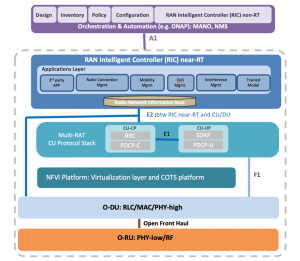
The group is calling for large scale O-RAN deployments from next year. “Macro deployment is the primary target”, says the group, adding that O-RAN small cells are also a target for indoors.
“A clear focus for Open RAN is on 3.4-3.8 GHz and a number of legacy FDD bands, while the interest in millimeter wave is tied to specific country availabilities,” says the document.
“Open X2/Xn are a baseline but a fully disaggregated RAN will also require an Open F1 interface for the CU-DU split of gNBs. Open E2 and A1 interfaces are also required and shall comply with the O-RAN ALLIANCE specifications to allow multi-vendor / multi0technology RIC deployment mid-term,” says the document, adding “for a unified SMO approach, interoperable O1 interfaces towards all the RAN nodes will be required, while the O2 interface will be needed for the SMO (Service Management & Orchestration) to operate the CNFs running on the O-Cloud infrastructure.”
The paper says that the mainstream implementation would be a Kubernetes-based O-Cloud (Open Cloud) platform supporting the necessary RAN software. For the software, a Containerised Network Function (CNF) on Bare Metal is the target solution.
The operators support cloud functions such as “the definition of auto-scaling policies for a given node pool, allowing the number of nodes to be scaled automatically according to metrics such as CPU and number of users.”
The O-Cloud platform should also support time-synchronisation (PTP, SyncE, GPS) and Hardware accelerators as well as an Acceleration Abstraction Layer (AAL) that provides a set of Open APIs to CNF applications for offloading the hardware accelerated functions.
The O-CU/ O-DUs will be implemented as CNFs on “power-efficient and reliable GPP CPUs with HW acceleration support for O-DU processing.”
The paper calls for variants for legacy bands, 3.4-3.8 GHz and millimetre wave spectrum, with various transmission modes (number of TRX), output power values and bandwidth requirements depending on frequency bands.
“Single band, dual band or triple band products are required depending on the respective bands. Support for multi-band O-RUs for low and mid bands is important for cost effective deployment. Massive MIMO products (32 and 64 TRX) are demanded primarily in 3.4-3.8 GHz. The main focus is on macro cell products, but small cell products are also needed, both indoor and outdoor.”
RIC receives approval saying it should bring enhancements in terms of programmability, with AI/ML enabled SON and Radio Resource Management applications related to traffic steering, QoS/QoE optimization, RAN slicing and Massive MIMO.
“Open E2 and A1 interfaces are the baseline requirements to allow multi-vendor RIC deployment from an early phase,” says the document.
Deployments must also be manageable within an automation and Service Management and Orchestration (SMO) framework, and here the operators says, “Automation & SMO Vendors shall adopt a unified data and information model (aligned with O-RAN ALLIANCE, 3GPP, ETSI and ONAP) to increase service management efficiency and vendor independent automation.
“The Service Management and Orchestration framework is a central RAN domain function to manage and control disaggregated multi-vendor RAN Network Functions (NF). The vision is to avoid vendor specific adoption of proprietary EMS (Element Management System) functions by using a unified modelling approach.”
“The SMO function requires defined Northbound Interfaces e.g., 3GPP, TM Forum Open API, or a defined functional split for OSS systems.”
‘Open fronthaul is considered as the key interface to implement a disaggregated, multi-vendor RAN, including massive MIMO, as a baseline for first macro deployments”.
“To become a competitive alternative to traditional RAN, the operators require solutions that will not compromise on network quality, security, high energy efficiency, as support for 4G and 5G based on both standalone and non-standalone, efficient RAN sharing and legacy band support”.
“Other capabilities related to an intelligent and programmable RAN are expected to emerge later, offering the potential for specialist start-ups to emerge and play an active role. All are essential in the long run to build a competitive open RAN ecosystem.”